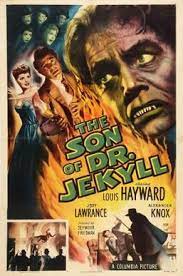
In 1860 Dr. Henry Jekyll’s alter ego Mr. Hyde murders his final victim, his wife. After being chased by an angry mob Hyde ends up at his family house in Mayfair. The mob sets the house on fire and Hyde dies when, trying to escape the flames, he falls from the roof of the house. Present are Dr. Jekyll’s friends John Utterson (Lester Matthews), the Jekyll attorney, and Dr. Curtis Lanyon (Alexander Knox), the executor of the estate and guardian of Edward. In the Soho flat where Jekyll’s wife was murdered they find an infant boy. Now an orphan Lanyon suggests that since Utterson and his wife are childless, they should adopt the boy.
Thirty years later Edward is an adult and is engaged to Utterson’s niece Lynn (Jody Lawrance). Edward is a student at the Royal Academy of Sciences. Before they can get married Edward ends up expelled from the academy for performing experiments that are unauthorized by the school. Lanyon is the executor of the Jekyll estate and is supposed to turn it over to Jekyll’s heir, Edward. He feels that it is necessary to inform Edward of his parentage and the circumstances of their death. He then gives Edward the key to the old Jekyll mansion.
Edward restores and moves into the mansion. The neighbors, however, are not too thrilled. Lanyon gives Edward his father’s notes on his experiment. Edward decides to try to recreate his father’s formula to prove that Jekyll did indeed succeed. Edward spends many nights and many attempts to recreate his father’s formula from his notes. At one point he appears to succeed. Edward calls together the press and others to witness a demonstration of his father’s formula. When Edwards takes the mixture again nothing happens.
Later that night a boy is attacked. Witnesses say it was Edward. Edward tells the police he has an alibi but the people he was with say he left early enough to have committed the crime. Edward’s life begins to fall apart. People begin to believe he is either another Hyde monster or just insane and should be in Dr. Lanyon’s sanitarium. Then the murders start to happen. Edward begins to get suspicious that there is more going on here than his father’s legacy. Is he really turning into Hyde or is someone else behind what is going on.
“The Son of Jekyll” was released in 1951 and was directed by Seymour Friedman. It is an American horror film and a continuing story based on the 1886 Robert Louis Stevenson story “The Strange Case of Doctor Jekyll and Mr. Hyde”. Writer Jack Pollexfen did a variation of this story for the 1957 film “Daughter of Dr. Jekyll”.
If you’re looking for the standard Jekyll and Hyde horror style film you may be disappointed. First, there’s only one transformation scene and it’s of Edward’s hand and not his face. Second, the movie is more mystery than horror. Third, even as a mystery it’s only a mystery to Edward. The audience knows who the bad guy is, and he is good at being devious while pretending he’s a friend.
The film is a little on the ambiguous side in spots. Did Edward really transform into Hyde or was he hallucinating? The beginning and the ending of the film are almost the same, making you question how many Mr. Hydes were there. The plot is a little slow but Louis Hayward’s performance as the slightly snarky Edward Jekyll made up for it. I enjoyed the film but more as a thriller than a horror movie.
This is another black and white film where the transformation from Jekyll to Hyde was done using different filters. Make-up was applied in contrasting colors. A series of colored filters that matched the make-up was then used which enabled the make-up to be gradually exposed or made invisible. The effect was also used in the silent movie “Ben-Hur: A Tale of Christ” 1925 and “Dr. Jekyll and Mr. Hyde” 1931. This effect is not possible in color films. The effect in this film was only done once and in passing so it’s easy to miss.

